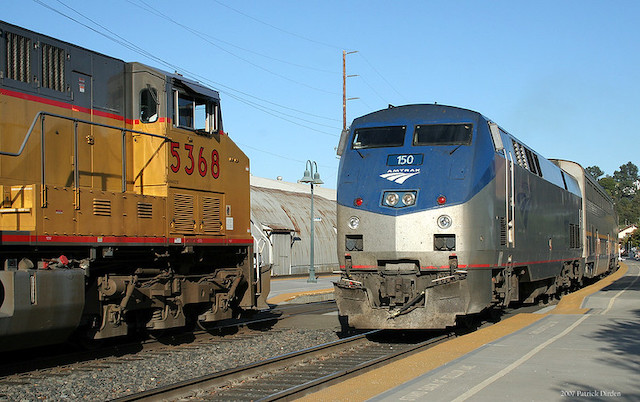At a time when almost everyone in the nation is affected by supply-chain problems but almost no one is riding Amtrak, the Federal Railroad Administration is frantic about how Amtrak trains are being delayed by freight trains. According to the agency’s latest report, Amtrak trains were delayed by a total of 1.3 million minutes (that’s 21,666 hours) in the first quarter of 2022, up 9 percent from the previous quarter.
Who is delaying whom? Photo by Patrick Dirden.
“The largest cause of delays was freight train interference at 299,252 minutes of delay — 22 percent of total delay minutes, an increase of 12 percent from the previous quarter,” says the report. However, the report makes no attempt to estimate the number of minutes of delays to freight trains caused by Amtrak. Passenger train delays, continues the report, caused a minuscule 2 percent of Amtrak riders — about 18,290 — who were connecting with a different train to miss their connections.
In the first quarter of 2022, Amtrak carried about 0.06 percent of all passenger travel in the United States. Freight trains, meanwhile, carried nearly 40 percent of all freight.
The FRA report notes, apropos of nothing else, that a whopping 0.56 percent of all Amtrak riders were on routes “not well-served by other modes of intercity transportation.” However, the report makes no attempt to calculate how much more it would have cost to ship freight by truck if the railroad capacities were squeezed by passenger trains. These are important issues now that Amtrak has billions of dollars to force its empty trains on the often-crowded tracks owned by the freight railroads.
Rail advocates frequently argue that getting more people on passenger trains saves energy. However, a recent report issued by the Bureau of Transportation Statistics finds that, when losses from electrical generation and distribution are counted, Amtrak trains used 3,587 BTUs per passenger-mile in 2020. That compares with an average of 920 BTUs for intercity buses and 2,851 BTUs for “short wheelbase” automobiles. (Automobiles with a wheelbase under 121 inches, which would include large SUVs such as a Cadillac Escalade but not full-sized pickups such as a Ford F-150.) Since the average Amtrak trip in the first quarter of 2022 was 210 miles long, buses and autos are Amtrak’s main competition.
Meanwhile, freight trains used 282 BTUs per ton-mile in 2020. The Bureau of Transportation Statistics hasn’t yet calculated BTUs per ton-mile for trucks, but trucks used about 16.4 billion gallons of fuel moving about 2 trillion ton-miles. Assuming that fuel was Diesel, which has 137,381 BTUs per gallon, trucks consumed about 1,125 BTUs per ton-mile, or about four times as much as trains. Those who truly want to save energy would dedicate the rails to freight, not passenger trains.
Thus, the best way to save energy as well as reduce delays to freight trains is to stop running Amtrak trains and get those passengers onto buses. For some reason, the FRA doesn’t consider that to be an option worth considering.









Note that 80% of Amtrak’s delays are __NOT__ due to freight railroads.
That is, 80% of Amtrak’s delays are either acts of god or self-inflicted.
Note amtrak…..carries 0.p6vtraffic….and has delays
It’s kind of ironic that too many freight trains cause Amtrak problems, but so do too few. If the freight traffic is too light on a particular route, the railroad will start downgrading the line, removing signals, going from double to single track, maybe even abandoning the entire route. That’s what would have happened to the National Limited if it had survived longer, and it almost happened to the Southwest Limited more recently. BNSF was, I think, going to practically give away that segment. “Here, take it if you want it, we don’t need it anymore.” Of course, then Amtrak would have to pay the entire costs to support a mere single-daily round trip.
Amtrak takes 7.5 hours from Emeryville to Reno, while the bus takes 4.25 hours. The trip from Reno to Emeryville is also notorious for being super late. While the train is fun and scenic, it’s not a fast or reliable way to get between the two cities, which are not served by non-stop commercial aviation.